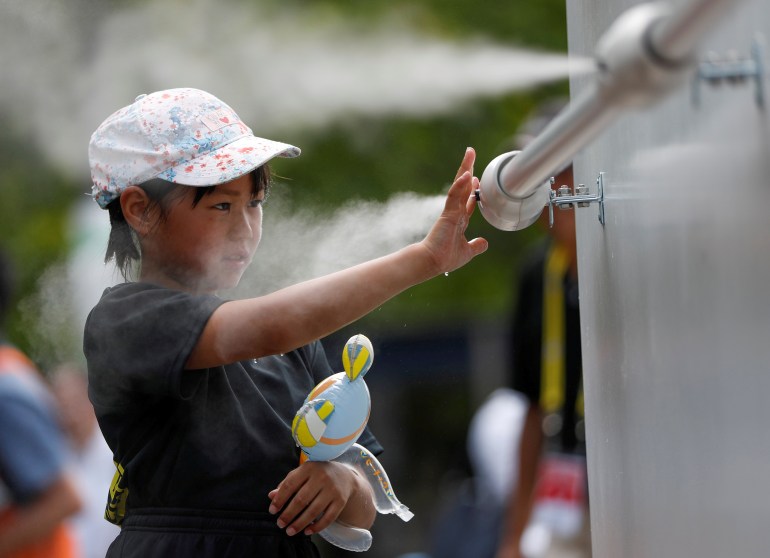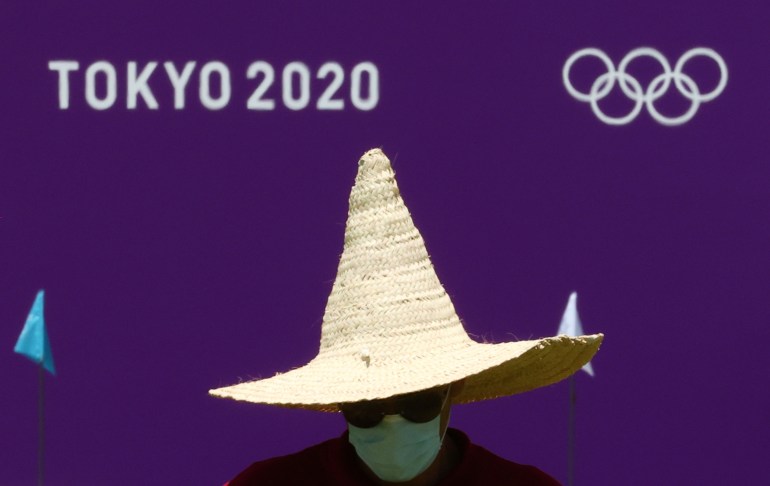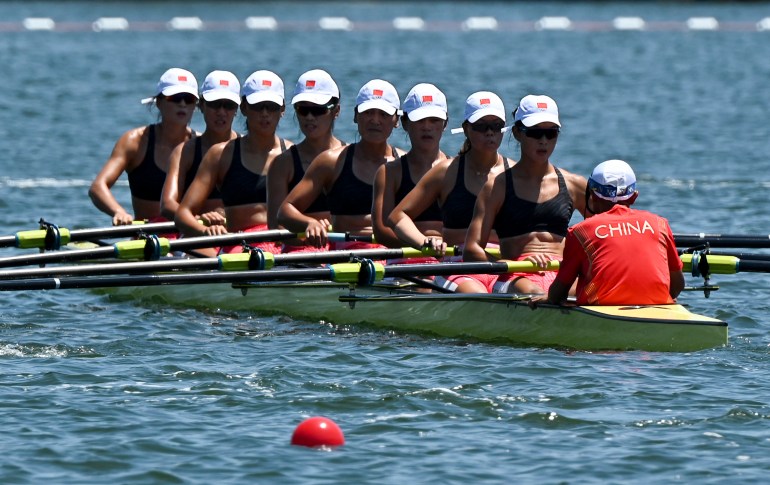Olympics face heat from broiling Tokyo summer
Tokyo is notorious for hot and humid weather in July and August raising concerns about the risk of heat-related illnesses.

Tokyo, Japan – As Japan prepares to hold the long-delayed Olympics on Friday, it is not only the coronavirus pandemic that is causing concern.
There are also worries about the potential threat to the health of athletes and staff from the weather – and the extreme heat and humidity of a Tokyo summer.
Keep reading
list of 4 itemsWHO chief backs Tokyo Olympics days before opening ceremony
First event of troubled Tokyo Olympics gets under way
Tokyo Olympics — The Essentials | Start Here
Ever since 2013 when Tokyo won its bid to host the Olympics, there has been concern about the decision to hold the event in late July and early August when temperatures usually reach a high of about 35 degrees Celsius (95 degrees Fahrenheit) and humidity ranges between 70 and 80 percent, making it feel even hotter.
Climate change has only been making the situation more uncomfortable.
Makoto Yokohari, professor of environment and urban planning at the University of Tokyo, tells Al Jazeera that according to his research, the Tokyo Games are set to be the “worst case” for an Olympic host city since at least 1986.
He explains that while other host cities reached temperatures that are similar to those of Tokyo, all of them had summer climates that were hot and dry, rather than hot and humid.
“When it comes to the risk of heatstroke,” he explained, “it is a combination between the temperature and the humidity.”
Worse, the typical symptoms of heatstroke are also quite difficult to distinguish from those of COVID-19.
“If there are a number of people who have heatstroke, I’m very concerned how they might be treated, and I don’t think we have the capacity to treat a big number of those people,” he said.

In recent years, Japan has been experiencing some of its hottest weather in modern history, accompanied by more frequent and intense rainfall and flooding events.
In 2018, at least 80 people died during a heatwave in Tokyo, and on July 23 – the same date as opening ceremony for the Tokyo Games – the temperature soared to 41.1C (106F) in Kumagaya, part of the Kanto plain that includes the capital.
It was an all-time record for Japan, although other recent summers have also come close.
The torrid temperatures of July and August also tend to see hundreds of deaths and tens of thousands of hospitalisations that authorities have attributed to heatstroke.
The decision by the Olympic organisers to hold the games without spectators due to the pandemic may have disappointed both international and local sports fans, but it did ease fears that elderly Japanese and others could succumb to the heat at the venues.
The latest weather forecasts suggest that the Olympic period will indeed be hot and humid, although there may be a period next week when rain helps bring the daily highs down by a few degrees.
‘Almost safe’ to ‘danger’
Organisers have taken some steps to reduce the risk to athletes, Olympic staff, and the media from the heat, or, worse, an untimely heatwave.
In late 2019, the International Olympic Committee (IOC), despite strong objections from Tokyo Governor Yuriko Koike, unexpectedly changed the venue of the Olympic marathon and walking events from the capital to the city of Sapporo on Japan’s northernmost main island, Hokkaido.
This move was reportedly prompted by IOC President Thomas Bach watching with horror the television images of marathon runners collapsing under the heat and humidity at the IAAF World Athletics Championships in Doha in September 2019. He wanted to avoid the risk of similar scenes in Tokyo.
At the beginning of this month, Japan’s Ministry of the Environment unveiled its English-language “Heat Stress Index for Surrounding Areas of Competition Venues”, which ranks on an hourly basis the heat threat at each Olympics venue. The five-step scale ranges from blue (almost safe) to red (danger).
The Olympic organisers are also implementing a variety of smaller countermeasures to protect the athletes and staff, including the widespread provision of mist machines, shaded benches, parasols, bottled water, air-conditioned rooms, and even ice baths and ice vests.

Some private businesses have also got in on the act. Last week, Ralph Lauren unveiled its “RL Cooling” self-regulating temperature jacket, which will be worn by Team USA’s flag-bearer during the Olympic and Paralympic Opening Ceremony Parades.
Chief Branding and Innovation Officer David Lauren explained in a press release that “recognising Tokyo’s summer heat, we sought to develop a solution for Team USA that fuses fashion and function – allowing them to look and feel their best on one of the world’s biggest stages”.
Despite their efforts, and the focus on COVID-19, the games’ organisers have not entirely escaped criticism over their preparations for extreme weather conditions.
Yoichi Masuzoe, who served as governor of Tokyo between 2014 and 2016 and was directly involved in the earlier rounds of preparation, raised his concerns on Twitter.
“The Olympics and outdoor competitions in this hot and humid environment are a battle against heatstroke,” he wrote in Japanese. “The marathon and racewalking have moved to Sapporo, but the competition in Tokyo will be horrible for the athletes.
“The decision to hold the Olympics in midsummer is due to television broadcasting rights. The 1964 Tokyo Olympics were rightly held in the autumn. This reflects the damage done by commercialism to the Olympics, which are now dominated by money.”
Masuzoe is not the only one to point out that the 1964 Tokyo Olympics, fondly remembered by many Japanese as a symbol of the nation’s economic recovery after World War II, were held in mid-October precisely in order to avoid the intense midsummer heat and humidity of the Japanese capital.
Norbert Palanovics, Hungary’s ambassador to Japan, recently visited his country’s team at its training camp.
Some of the 176 athletes will be competing in sports that are directly exposed to the summer sun, such as in triathlon or kayaking.

The ambassador says these athletes are taking special care to remain hydrated and that they are accompanied by dietitians who “fine-tune” the kinds of foods that they consume to the hot weather and humidity.
“The information that we received at the embassy was quite extensive,” Palanovics said. “The organisers have prepared extensively by trying to show the dangers of the Japanese heatwave, so that the athletes and the teams can prepare to the maximum extent possible.”
Even the delegations of countries with very cool climates believe that they are prepared.
Raido Mitt, the coordinator of sports federations and Team Estonia, says his Baltic nation’s 33 athletes include marathon runners, horse riders, rowers, and others. In order to prepare for the Tokyo Games, they trained in special indoor facilities in Estonia under very hot temperatures.
He expressed confidence that his nation’s athletes were up to the climatic challenges that they are facing.
“Everyone knows that the conditions are very tough and they have prepared for these kinds of conditions.”